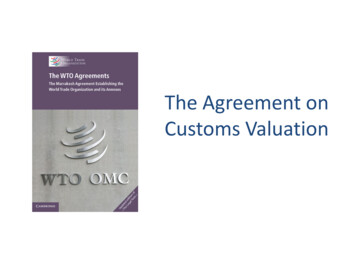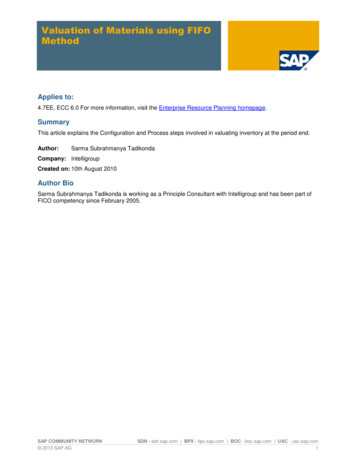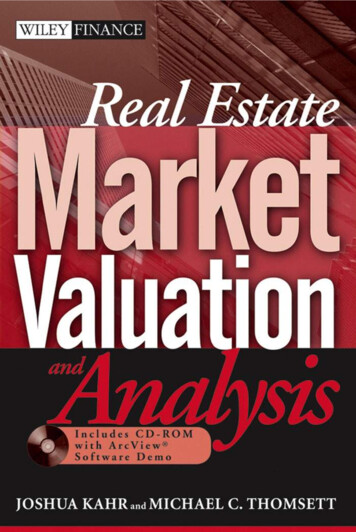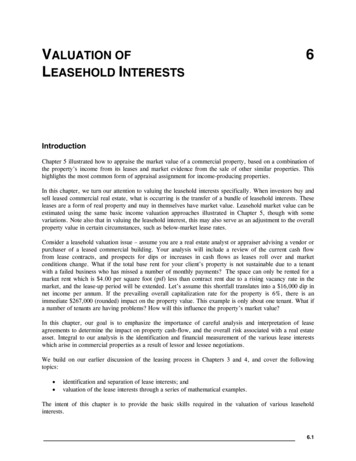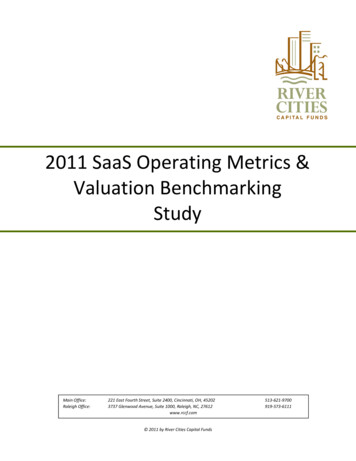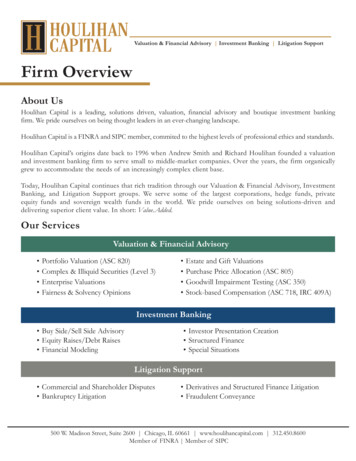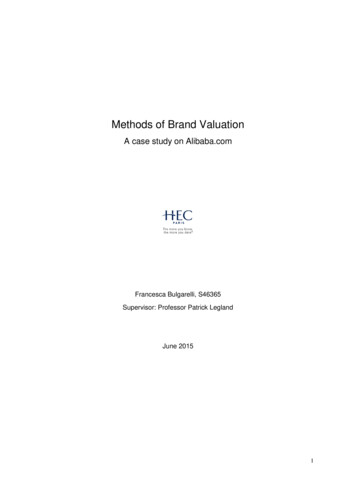
Transcription
Methods of Brand ValuationA case study on Alibaba.comFrancesca Bulgarelli, S46365Supervisor: Professor Patrick LeglandJune 20151
AbstractBrands are seen as strategic assets whose value is strongly correlated to companies’value. The relevance of brand valuation goes from marketing portfolio optimization andstrategic positioning, M&A pricing, to the day-to-day business for royalty rates definition. Thedifficulty in brand valuation starts from the definition of brand. Each enterprise has a namewhich defines its identity, but some brands goes beyond a simple label. In some cases, thebrands become evocative of a concept, a product and a style, they represent a guarantee. Itis difficult to draw a line between which brand should be considerate only the identification ofa company/product and which has a value in itself. When this is the case, brands areintangible asset as strategic and valuable as the least identifiable when looking at thefinancial statement. Moreover, the various methodologies of valuation lead to discrepancies,depending also on the valuator and the valuation variables. Despite the importance of thetopic, little literature has been developed on it and there is no consensus in standardpractice. The main purpose of this paper is to give a contribution to the literature gatheringthe various methodologies defined by academics and used by practitioners. The analysis isconducted to shedding light on the main features of each of them. A case study follows.Using the most relevant methods, a brand valuation of the recent e-commerce giantAlibaba.com has been pursued. The study is particularly suitable to grasp the relevance ofbrands' value because of the magnitude and variability of the valuation results and of thecharacteristics of the industry of interest, internet-retail.2
Table of Contents1. Introduction . 62. Objectives and Consequences of Brand Valuation . 73. Problems in brand valuation. 83.1Discount Rate. 83.2Brand Lifetime .104. Consumer-based Approach to brand valuation .104.1Models .114.1.1 Conversion Model .114.1.2 Customer Preference Model .115. Financial-based Approach to brand valuation .115.1The Cost-based approach .125.1.1 Historical Cost of Creation Method.125.1.2 Cost to recreate Method .125.1.3 Replacement Cost Method .135.1.4 Capitalization of Brand-Attributable Expenses Method.135.1.5 Residual Value Method .135.2. The Market-based Approach .145.2.1 Brand Sale Comparison Method .145.2.2 Brand Equity Based on Equity Valuation Method .145.2.3 Residual Method .155.3The Income-based Approach .155.3.1 Price Premium Method .155.3.2 Demand Driver/Brand Strength Analysis Method .165.3.3 Gross Margin Comparison or Economy of Scale Technique .175.3.4 Operating Profit Comparison Method .175.3.5 Royalty Relief Method .175.3.6 Excess Cash Flow Method .195.3.7 Marginal Cash Flow Model .195.3.8 Company Value With and Without Brand Method .205.3.9 Excess Margin Model.205.3.10 Competitive Equilibria Analysis Model .205.3.11 Corebrand Value plus the Value of Other Related Assets Method .215.3.12 Customer Lifetime Value method .215.3.13 Brand equity based on differences in ROI, ROA and EVA Model .215.3.14 Differential of Price to Sale ratios Method.213
6. Other Brand Valuation Approaches.226.1Interbrand Approach.226.2Cost of Creation and Development plus a Percentage of Historical IncomeMethod 236.3Formula Based on Accounting Data Method .236.4Multiples Based on Proprietary Research Data Method .236.5Percentage of Market cap Attributable to the Brand Method .246.6Real Options Method.246.7Stock Price Movements Method .266.8Valuation Model based on the Capital Asset Pricing Model .266.9Scanner-based Measure .266.10 McKinsey Brand Valuation Model .266.11 Icon Research and Consulting Brand Trek Approach .277. Formulary Approaches.277.1Financial World Magazine Method .277.2Brand Equity Ten Method .277.3Brand Finance Limited .288. Composite economical and behaviourally-oriented brand valuation models .288.1Semion Brand Value Approach .288.2Bekmeier-Feuerhahn’s Market-oriented Brand Valuation Model .288.3Portfolio Models of Brand Value .298.4Sattler Brand Value Approach .298.5Integrated Model of Brand Valuation .299. Summary of the methods analysed .3110. Case Study - Alibaba.com .3410.1 Market overview .3410.2 The choice of Alibaba .3510.3 Alibaba - Overview and History .3510.4 SWOT Analysis .3710.5 Financial Statements .3810.6 The brand .4010.7 Comparable non branded company.4010.8 WACC Computation .4210.9 Benchmark Valuations .4310.10 Royalty Relief Method .4410.11 Price/Volume Premium Method .4610.12 Margin Comparison Method .504
10.13 Excess Cash Flow Method .5110.14 Historical Cost Method .5210.15 Replacement Cost Method .5410.16 Transaction Multiple Method.5510.17 Demand Driver Approach .5710.18 Real Options Method .6010.19 Results Summary .66Appendix .67Bibliography .685
1. IntroductionModern accounting systems define goodwill as the measure of financial markets’ positiveattitude towards the future of a company and allocate it to the specific items that brought toits creation such as brands, patents, databases and know-how. However, only the brandsthat have been bought individually, or that were included in the price paid for a company canbe posted in the balance sheet of the acquiring company because the accounting principle ofprudence requires evaluations to be valid, coherent and reproducible. Then, in those casesthe overall price paid gives an upper limit to the brand value.Recent academic literature shows and underlines the advantages of computing andunderstanding brand value and gives explanations to why it should not be restricted tomergers and acquisitions. First of all, brand valuation is crucial to create a strong brand. Itensures that resources are appropriately channelled to obtain the highest value: specifically,it helps the company to define the correct level of marketing expenses and to impose brandlicensing fees that exactly reflect the benefit delivered. Furthermore, brand valuation allowsto evaluate the brand manager performance and compensation evolution and to create anincentive scheme helping in decision-making processes and in marketing trainings.Considering that valuation results are different according to the aims and objectives defined,there cannot exist a single, unique value for a brand. Particularly, value could be defined asthe value of liquidity in the case of a forced sale or as the value for partial assets sale; itcould be the book value for the company accounts, or the value to be paid in case of atakeover or of a merger. Finally, it could be the value that is needed in order to estimate theprice of licenses. Many definitions of brand value are therefore reflected in different brandvaluation approaches and methods. All in all, depending on the valuation objective andmethod, the final result will be more or less reliable, more or less subjective, based onhistorical or forward-looking.The aim of this thesis is to present the different approaches to brand valuation, analyse indetail theoretical methods and commercially used models and then evaluate the mostimportant ones with an empirical study.6
2. Objectives and Consequences of Brand ValuationModel of Organizational and Behavioural Implications of Brand ValueAccounting- Chris Guilding and Richard PikeThe Model of Organizational and Behavioural Implications of Brand Value Accounting byChris Guilding and Richard Pike clearly shows the different objectives and consequences ofbrand valuation.Model of Organisational and Behavioural Implications of Brand Value AccountingBudgetary RoleImplication Derived fromBudgetary RoleIntervening factorImpact on LongTerm Brand ValueBrand Managers perceive brand value asincomplete performance measure (1)PerformanceEvaluationDysfunctional behavi
Technical issues such as separating brand equity from other intangibles and assessing the brand’s useful life and the required rate of return on intangible assets, further increase the difficulty of valuing brands. We will go into more detail regarding the discount rate determination and the brand lifetime in paragraphs 3.1 and 3.2. Moreover, the lack of an active market for brands means .



